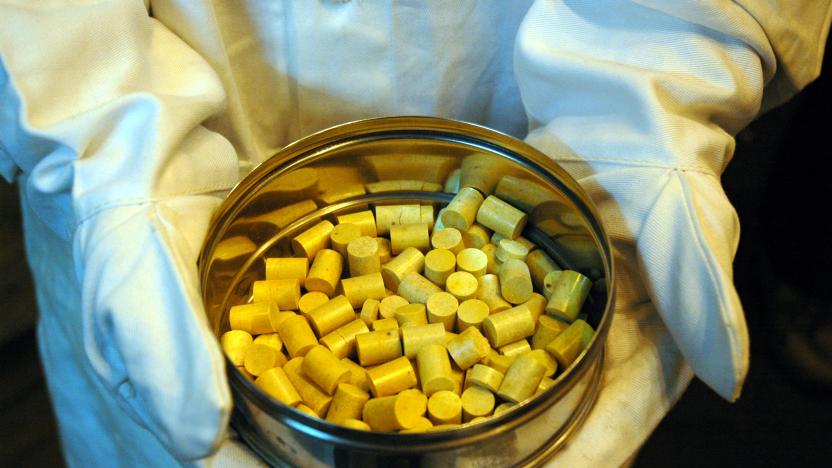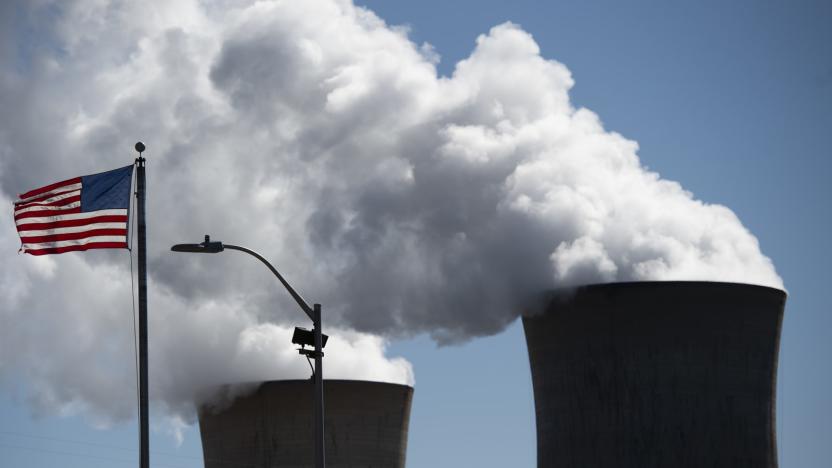nuclear power
Latest

UK Space Agency funds Rolls-Royce's bid to put a nuclear reactor on the moon
Rolls-Royce is creating a nuclear micro-reactor to power future moon bases.

NASA picks three companies to develop lunar nuclear power systems
A fission system could power long-term missions to the Moon and Mars.

China plans to build the first 'clean' commercial nuclear reactor
China is planning to build a thorium-based nuclear reactor that could be cleaner and safer than conventional options.

DARPA picks Lockheed Martin and Blue Origin to build nuclear spacecraft
DARPA has picked Jeff Bezo's Blue Origin, Lockheed Martin and General Atomics to build and demonstrate a spacecraft driven by nuclear thermal propulsion.

The case for making tiny nuclear reactors
In the US, the electricity powering your home was probably generated by burning natural gas, a fossil fuel. As coal becomes unfeasible, renewables work toward scale and nuclear is benched, gas remains the go-to for power companies. Industry analysts talk about gas as the "bridge," the fuel we can burn now to buy us time to develop our carbon-free future.

Three Mile Island's infamous nuclear plant shuts down after 45 years
An important if ignominious chapter in American nuclear energy has come to a close. Exelon has shut down Three Mile Island's Generating Station Unit 1 reactor after 45 years of use. The reactor isn't the one behind the accident in March 1979, but this effectively marks the closure of the plant -- Unit 2, the reactor that failed, has been dormant for the past 40 years. It didn't directly provide a reason, but it had warned in 2017 that it would shut down the plant in 2019 due to the high running costs.

Is it time we gave nuclear power another chance?
350 parts per million. That's the figure scientists agree is the "safe" upper limit of carbon dioxide in our atmosphere. Beyond that point, it's increasingly likely that our planet will become inhospitable for the humans that cling to its surface. Crops will fail, sea levels will rise and millions, if not billions, will die in catastrophic weather events. The National Oceanic and Atmospheric Administration's Mauna Loa Observatory reports that levels have now reached 409.9 parts per million.

MIT designs a floating, tsunami-proof nuclear plant
What's the safest place to put a nuclear reactor? Offshore, apparently. A new power plant design concept from MIT envisions a facility built on floating platforms, moored in deep water several miles off the coast. This, the concept's creators explain, lends it several crucial advantages -- making it virtually immune to earthquakes, tsunamis and meltdowns. Big promises, to be sure, but the professors' reasoning actually makes sense: in deep water, tsunami waves aren't large enough to cause significant damage, and earthquakes are usually only felt if you're standing on the earth. Floating the reactor on the ocean also gives the plant access to easy, passive cooling, what MIT's Jacopo Buongiorno calls an "infinite heat sink."

Stuxnet pinned on US and Israel as an out-of-control creation
Ever since Stuxnet was discovered, most of the accusing fingers have been pointed at the US, Israel or both, whether or not there was any evidence; it was hard to ignore malware that seemed tailor-made for wrecking Iranian centrifuges and slowing down the country's nuclear development. As it turns out, Occam's Razor is in full effect. An exposé from the New York Times matter-of-factly claims that the US and Israel coded Stuxnet as part of a cyberwar op, Olympic Games, and snuck it on to a USB thumb drive that infected computers at the Natanz nuclear facility. The reason we know about the infection at all, insiders say, is that it got out of control: someone modified the code or otherwise got it to spread through an infected PC carried outside, pushing Obama to either double down (which he did) or back off. Despite all its connections, the newspaper couldn't confirm whether or not the new Flame malware attack is another US creation. Tipsters did, however, deny that Flame is part of the Olympic Games push -- raising the possibility that there are other agencies at work. [Image credit: David Holt, Flickr]

Scientists bend gamma rays, could neuter radioactive waste (update: more credit)
Bending most light is easy; bending it in gamma ray form, however, has often been deemed impossible given how hard it is for electrons to react to the extreme frequencies. LMU Munich scientist Dietrich Habs and his Institut Laue-Langevin teammate Michael Jentschel have proven that assumption wrong: an experiment in blasting a silicon prism has shown that gamma rays will refract just slightly through the right material. If a lens is made out of a large-atom substance like gold to bend the rays further, the researchers envision focused beams of energy that could either detect radioactive material or even make it inert by wiping off neutrons and protons. In theory, it could turn a nuclear power plant's waste harmless. A practical use of the technology is still some distance off -- but that it's even within sight at all just feels like a breakthrough. Update: The research also involved the Max Planck Institute of Quantum Optics' Marc Günther. Thank you, Dr. Günther.

Fukushima technician gives behind-the-scenes look at the cleanup operation
New details about the robotics deployed to help clean up Japan's Fukushima nuclear plant have emerged, thanks to a series of blog posts penned by an anonymous technician. Known only as 'S.H.', the blogger wrote of the effectiveness of the donated iRobot Packbots and Warriors (despite their prolonged exposure to electronics-damaging radiation), while criticizing the Tokyo Electric Power Company for what he saw as inept supervision, unreasonable schedules and disregard for technician safety. S.H., who helped retrofit a vacuum cleaner onto a robot to collect radioactive dust, also revealed technical details about the robots, explaining that they were manipulated with a PlayStation-style controller via a Panasonic Toughbook and that the devices were most effective in pairs, which allowed for better wireless connectivity and faster emergency response. The site was taken down after it began circulating on Twitter but IEEE kept and translated the posts, available for your perusal at the source link, below.

Fukushima plant operator uses modded robot vacuum to suck up radioactive dirt (video)
A few months ago, back when Japan was freshly reeling from that devastating earthquake and tsunami, it became obvious that robots could help survey radiation levels in Fukushima, even if they were powerless to lower them. Now, Tokyo Power Electric Co., the company that operates the damaged nuclear plant, is experimenting with an ad hoc system designed to clean at least some of the radioactive dirt from the reactors. What you see in that clip below is an industrial-grade vacuum cleaner attached to a Warrior, the most heavy-duty of iRobot's mobile bots. The idea is that workers can control the system from a safe distance, and let the robot handle the dirty work of removing toxic sand and debris. Head past the break to see it in action, combing the floor of the (eerily) empty plant.

NASA abandons Mars rover Spirit, chooses to remember the good times
More than a year after it first lost contact with its Mars rover Spirit, NASA has finally decided to throw in the towel. Yesterday, the agency confirmed that it will end all planned communications with the robot on May 25th, effectively ending the craft's seven-year mission. NASA was hoping that the approaching Martian spring would allow the Spirit to recharge its solar panels and re-establish radio contact, but it now appears that the craft sustained irreparable damage last winter, when it was forced to endure brutally cold temperatures. NASA executive David Lavery, however, says the rover team will remember the Spirit more for its achievements than its slow demise: "I think we'll all sit around and have a sip of Guinness and reminisce about when Spirit was a wee small little rover and look back at the accomplishments and successes rover had over its entire lifetime." So the Spirit's spirit will live on, but what about NASA's mission to Mars? Well, the Opportunity is still in good health and, later this year, will be joined by the next-generation, nuclear-powered rover Curiosity, which will investigate whether or not Mars ever supported life forms. Meanwhile, NASA's network of orbiting spacecraft will continue to passively listen for signals from the Spirit, just in case it miraculously comes back to life. Full PR after the break.

Nuclear fusion startup gets Jeff Bezos backing, won't be dropping any bombs
Here's a phrase we never though we'd utter: Bezos is the bomb! Okay, so maybe a nuke reference isn't exactly appropriate here, considering Jeff Bezos is actually backing a company that's looking to create cheap energy through nuclear fusion, but we couldn't resist. General Fusion, a nuclear fusion startup, released a statement today saying that it has completed a $19.5 million round of funding that included backing by the Amazon founder's Bezos Expeditions. According the company's website, General Fusion's approach to generating "safe and plentiful" energy employs a concept created about 30 years ago called "magnetic target fusion," and expects commercialization of its process could come before the end of the decade. Full PR after the break.

iRobot Packbots enter Fukushima nuclear plant to gather data, take photos, save lives (video)
iRobot recently deployed a pair of robots to the Fukushima Daiichi nuclear plant in Japan, where intense levels of radiation have made it increasingly dangerous for human rescue workers to operate. The remote-controlled Packbots entered one of Fukushima's reactor buildings on Sunday morning, in the hopes of providing authorities with a better idea of what's going on inside the plant's nether regions. Each Packbot entered the facility with an attached video camera, allowing Tokyo Electric Power (TEPCO) to receive live interior images and temperature readings of the troubled reactor building. It would certainly be a daunting task for any human to undertake, but the Packbot is specially designed to cope with hazardous conditions (in the past, it's been used to defuse bombs for the U.S. Army). And the Packbot isn't alone, either. Authorities are also using a mechanical excavator and transporter to wipe away some of the debris outside the plant, while an unmanned helicopter has been hoisted skyward, to take aerial photos of the area. TEPCO has yet to release information on the Packbots' findings, but if Sunday's mission proves to be a success, they'll be sent in to two other reactor buildings, to do it all over again. Check out a video and an extra image of the Packbot, after the break.

TALON robot gets declawed, helps Japan sniff out radiation (video)
Robotics experts at the Department of Energy's Idaho National Laboratory just taught an old war machine some new tricks, namely radiation detection -- a timely acquisition of knowledge, for sure. Swapping out rocket launchers and machine guns for a suite of radiological sensors, digital cameras, and a GPS device, this modified TALON will be used to map the radiation levels (and create a visual output) surrounding the Fukushima nuclear power plant. The newly modified TALON landed in Japan just last week, joining an existing team of robot helpers already in use in the disaster area, including two additional TALONs equipped with sensors that can identify more than 7500 environmental hazards. Guns for Geiger counters seems like a good trade to us; check the video up top to watch the 'bot try out its treads. [Thanks, John]

Inhabitat's Week in Green: LAVA's geodesic home, solar skyscraper glass and fear of nuclear power
Each week our friends at Inhabitat recap the week's most interesting green developments and clean tech news for us -- it's the Week in Green. This week Inhabitat showcased several groundbreaking feats of high-tech architecture - starting with plans to transform the United States' tallest skyscraper into a soaring solar farm. We also saw a vision for a geodesic home of the future that is popping up in China this year, and we learned that scientists in Qatar are developing a series of solar-powered artificial clouds that will cool the country's stadiums during the 2022 World Cup. It was a big week for energy news as well as Germany and Italy announced plans to abandon nuclear power in the wake of the crisis in Japan. Tata & MIT also announced a breakthrough technology for generating power from water, and we saw solar energy reach new heights as Suntech set off to install the world's tallest solar plant on the Tibetan Plateau. Speaking of soaring green designs, we watched a brand new electric vehicle take to the skies as the solar-powered Elektra One airplane successfully completed its maiden flight. This week we also showcased several cutting-edge examples of wearable technology including an app that instantly transforms any drawing into a made-to-measure dress. We also learned that Virgin Atlantic now offers passengers bespoke shoes while they wait, and we took a look at a futuristic pregnancy belt that offers an inside look at the womb. Finally, we saw several amazing examples of recycled design - Chinese artist Wing Wah has created a set of scrap metal transformer robots that look just like the movies, and designer Mati Karmin has transformed defused land mines into an edgy set of interior furnishings.

Monirobo measures radiation following nuclear crisis at Japan's Fukushima Daiichi power plant
According to a report by a Japanese news agency, a radiation monitoring robot, aptly named Monirobo, is the first non-human responder to go on-site following the partial meltdown at the Fukushima Daiichi nuclear power plant. The machine, which was developed by Japan's Nuclear Safety Technology Centre to operate at lethal radiation levels, reportedly began work Friday, enlisting a 3D camera, radiation detector, and heat and humidity sensors to monitor the extent of the damage. A second Monirobo, used to collect samples and detect flammable gases, is expected to join its red counterpart soon -- both robots are operated by remote control from distances up to one kilometer away. They join the US Air Force's Global Hawk drone in unmanned surveillance of the crisis.

Obama's 2012 budget includes push for 'mini-nuke' reactor development
The President revealed his 2012 budget proposal today, including $853 million for nuclear energy research -- which includes development of "mini-nukes," or small, modular reactors that can be shipped and deployed relatively quickly, and built relatively cheaply (up to $2 billion, as opposed to the $10 billion price tag of your traditional reactor). But don't get excited -- you won't likely be able to get your own backyard reactor just yet. For the time being, they're to be placed in existing large-scale labs like the Oak Ridge National Laboratory in Tennessee. It is hoped that the reactors will bring a 28 percent reduction of the Energy Department's carbon footprint by 2020.

Inhabitat's Week in Green: wind towers, viaduct power and how Four Loko will be recycled into gasoline
Each week our friends at Inhabitat recap the week's most interesting green developments and clean tech news for us -- it's the Week in Green. It was a monumental week for eco architecture as renewably-powered projects sprung up around the world. Japan unveiled plans for a massive new type of wind power tower, and we were wowed by a proposal to transform abandoned Italian viaducts into high-tech energy centers. We also showcased a solar-powered Dutch pavilion that can generate as much power as it consumes, and we were awestruck by one designer's plan for a crazy vertical skyscraper amusement park. In other news, eco transportation blazed a trail as a student-designed solar car smashed a world speed record. The recently released Chevy Volt outsold the Nissan Leaf by a huge margin last month, and we took a look at a breakthrough battery tech that could enable electric vehicles to charge 40 times faster. We also saw efficient aviation take to the skies as Honda launched a new jet that consumes 20% less fuel than comparable planes, and speaking of jet fuel, this week we learned that banned Four Loko beverages are being recycled into engine-ready ethanol. We also watched China light up the newswires with energy news as they announced the imminent construction of the world's largest solar plant and found a way extend the life of nuclear fuel by 60 times. Finally, this week we celebrated all of the hot new media tech at CES with a look at Lady Gaga's shutter-fly sunglasses, and we brought you a guide to how kids can use technology to create online media.








